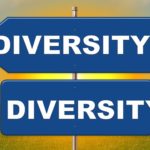Diversity, inclusion, belonging – are we there yet?
For as long as I can remember recruitment campaigns have been searching for ‘The Holy Grail’ – that day when they have a shortlist of diverse interviewees who reflect the communities and workforce they serve. My experience of working with the organizations over the years as an external panel member in the selection of non-executive directors to NHS Trusts and recruitment to expert bodies is that this grail is as elusive as ever.
However, every organization I’ve worked with wants diversity. I know they want it because they say they do. They say it everywhere – in policies, at presentations, seminars, training courses, on websites, on application forms and every advertisement for a post. Usually at the bottom of the page, somewhere in the small print, you will see the ever-expanding statement, trying to keep up with changes in Equalities legislation.
 It can read like a list from the thesaurus. We would welcome, are committed to, are working towards, respect (respect and value), and recognise. I could list more but you get the point. Organizations say it all the time.
It can read like a list from the thesaurus. We would welcome, are committed to, are working towards, respect (respect and value), and recognise. I could list more but you get the point. Organizations say it all the time.
However, according to Roger Kline author of The “snowy white peaks” of the NHS, we are not increasing the numbers of people from ethnic minority backgrounds for example in the NHS senior executive or non-executive roles. The NHS has 1.3 million people working for it. A HSJ survey in 2008 found that 16% were from an ethnic minority background; while Kline’s report found that in 2013, 5.8% of those with an ethnic minority background were non-executives while senior and very senior staff were 5.9%. This is despite many initiatives – NHS Leadership programmes, Bevan, Seacole, Nye ….and research.
I shouldn’t doubt the commitment. Staff are briefed, watch webinars, sent emails and reminders of the values and expected behaviours of the organizations. They are also sent on training courses. They usually have at least one of the following words or phrases in the titles: ‘under-representation, diversity, inclusion, equality, fairness and recently ‘unconscious bias training/awareness raising – although after all this time, I would have thought the title should be ‘conscious bias!’. They are told about the economic value, the social value, CSR, governance best practice and why diversity ultimately makes sense for patients, the organization and stakeholders.
However, what keeps coming back to me are two points:
- While undertaking training in Solution Focused Counselling the trainer reminded us that we spent two-thirds of our time discussing the problem and not enough time on the solution.
- The second point is– ‘the problem is not the problem’. We no longer work on the ‘problem’. We’ve become stuck in the ecosystem that has grown up researching the problem, developing better data collection, organizing and re-organizing the metrics, re-writing policies, writing new policies and improving reporting systems.
We’ve become stuck in a systems, processes, numbers vicious circle. We continue to be told that we need more women – what should we aim for? Should it be 25%, 30% or 40%? A few years ago at an ESRC seminar at Aston University on Equality Diversity & Inclusion Binna Kandola helpfully told us the figure was 50%. (Just think about that for a moment and you’ll get it). We keep going round and round the same issues and yet little changes.
It’s time to take action, so don’t say it if you don’t mean it. If you say you are committed, why not try the Neil Armstrong approach – one small step, one giant leap!
You know that criterion usually found at the end of job descriptions; they all have it, they say things like … ‘demonstrate understanding of diversity, must have a commitment to’… etc. Try putting that criterion first – then stand back and listen to the reasons why you can’t! You might be surprised how the discussion goes. However, why should putting it first be a problem? Just take a look at your organization’s diversity statement. You are, after all committed to increasing the under-representation of diverse groups, and you welcome applications from under-represented communities. What better way to demonstrate that than by making sure it’s the first criteria applicants read in the person specification for the role they have applied?
After all, you wouldn’t say it if you didn’t really mean it – would you?
